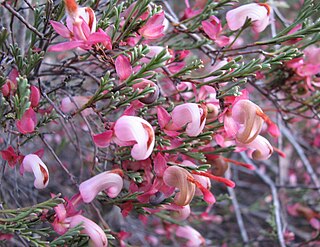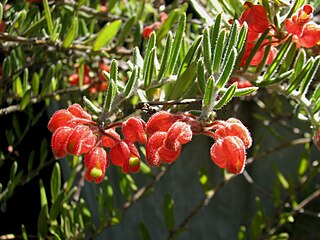Banksia undata var. splendens is a shrub endemic to Western Australia.

Grevillea involucrata, also known as Lake Varley grevillea, is a low-growing shrub which is endemic to the south-west of Western Australia. It grows up to 0.5 metres in height and produces pink flowers between June and October in its native range.

Grevillea pilosa is a low growing shrub which is endemic to the south-west of Western Australia. It grows to between 0.4 and 1 metre in height and produce red or pink flowers between June and December in its native range.

Grevillea ripicola, commonly known as Collie grevillea, is a shrub which is endemic to the south west region of Western Australia. It grows to between 0.6 and 2 metres in height and up to 4 metres in width. The species was first formally described by botanist Alex George in Nuytsia in 1974 based on plant material collected at Collie. It is classified as Priority Four Flora (Rare) under the Wildlife Conservation Act in Western Australia.

Acanthocarpus is a genus in the family Asparagaceae, subfamily Lomandroideae, in the APG III system of classification. It has been difficult to place at family rank, being placed at various times in Dasypogonaceae as well as the Asparagaceae. The entire genus is endemic to the State of Western Australia.

Acanthocarpus preissii is a rhizomatous perennial that occurs on coastal dunes in Western Australia. White flowers appear between April and May in the species' native range.
Actinobole condensatum is a dwarf annual herb, endemic to Western Australia.
Banksia borealis subsp. borealis is a subspecies of Banksia borealis. As an autonym, it is defined as encompassing the type material of the species. It was known as Dryandra borealis subsp. borealis until 2007, when Austin Mast and Kevin Thiele sunk all Dryandra into Banksia. As with other members of Banksia ser. Dryandra, it is endemic to the South West Botanical Province of Western Australia.
Banksia gardneri var. gardneri is a variety of Banksia gardneri. As an autonym, it is defined as encompassing the type material of the species. It is native to the Southwest Botanical Province of Western Australia.

Banksia gardneri var. brevidentata is a variety of prostrate shrub that is endemic to the south-west of Western Australia.
Banksia gardneri var. hiemalis is a variety of Banksia gardneri. It is native to the Southwest Botanical Province of Western Australia. Seeds do not require any treatment, and take around 19 days to germinate.

Banksia laevigata subsp. fuscolutea is a subspecies of Banksia laevigata. It is native to the Southwest Botanical Province of Western Australia.
Banksia leptophylla var. melletica is a variety of Banksia leptophylla. It is native to the Southwest Botanical Province of Western Australia.
Banksia meisneri subsp. ascendens, commonly known as Scott River banksia, is a subspecies of Banksia meisneri. It is native to the Southwest Botanical Province of Western Australia.
Banksia nutans var. cernuella is a variety of Banksia nutans. It is native to the Southwest Botanical Province of Western Australia. Seeds do not require any treatment, and take around 17 days to germinate.

Banksia sphaerocarpa var. caesia is a variety of Banksia sphaerocarpa. It is native to the Southwest Botanical Province of Western Australia.
Banksia leptophylla var. leptophylla is a variety of Banksia leptophylla. It is native to the Southwest Botanical Province of Western Australia. As an autonym, it is defined as containing the type specimen of the species.

Trapezites sciron, the Sciron skipper, is a butterfly of the family Hesperiidae. It is found in the Australian states of Western Australia, South Australia and Victoria.

Grevillea saccata, commonly known as pouched grevillea, is a shrub which is endemic to the south-west region of Western Australia. It grows to between 0.25 and 0.5 metres in height. The red flowers usually appear from June to November in the species' native range. The species was formally described in 1870 by English botanist George Bentham in his Flora Australiensis.

Franklandia fucifolia, or lanoline bush, is native to the south-west of Western Australia. It is a species in the Franklandia genus of the Proteaceae family.










